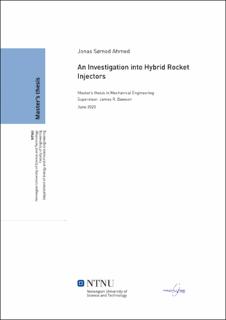| dc.contributor.advisor | Dawson, James R. | |
| dc.contributor.author | Ahmed, Jonas Sømod | |
| dc.date.accessioned | 2021-09-20T16:47:00Z | |
| dc.date.available | 2021-09-20T16:47:00Z | |
| dc.date.issued | 2020 | |
| dc.identifier | no.ntnu:inspera:57317709:20929650 | |
| dc.identifier.uri | https://hdl.handle.net/11250/2779621 | |
| dc.description.abstract | Propulse NTNU er et nylig oppstartet rakettlag for studenter som nå forsøker å bygge en hybrid-rakett. Fordi dette er en ny organisasjon er det et behov for å samle kunnskap om hvordan raketter og deres nøkkelkomponenter fungerer. En av nøkkelkomponentene er injektoren, og dens rolle er å levere en spesifik massestrømningsrate av flytende oksidant som en velatomisert spray til forbrenningskammeret i raketten. Denne oppgaven har blitt skrevet for å skape et basis for injektordesign som Propulse kan bruke i fremtidige år.
De viktigste aspektene ved injektoren er strømningsraten av oksidant som leveres samt andre strømningsegenskaper som kan forbedre rakettens ytelse. Dette har først blitt sett på gjennom et literaturstudie som dekker bakgrunnsteorien som er nødvendig for å forstå hvordan injektoren fungerer i rakettmotoren. Modeller for massegjennomstrømningen er så blitt utviklet for å forutsi strømningsraten. Enfase-modeller er presentert først som en grunnlinje, men fordi lystgass er blitt valgt som oxidant er tofasemodeller nødvendig. Dette er grunnet det høye damptrykket til lystgass, som vil gjøre at damp dannes inne i injektoren. Til slutt blir beregninger fra disse modellene brukt til å designe noen få preliminære injektorer med CAD.
Det ble funnet ut at strømningen gjennom injektoren kan strupes for realistiske driftsforhold, som vil gjøre strømningsraten uavhenging av trykksvingninger i brennkammeret og redusere ustabilitet. Dermed kan strømningsraten gjøres konstant dersom trykket i tanken er konstant og strømningen strupes. Det viste seg derimot at tank-trykket og dermed strømningsraten vil falle, grunnet de dynamiske egenskaper av lystgasstanker som tømmes. Ved å bruke strømningsratemodeller som tar tank-dynamikken i betraktning ble en metodologi for å designe injektorer som leverer en gitt gjennomsnittlig strømningningsrate utarbeidet. Det var planlagt å utføre eksperimenter som ville vært nyttige for validerering, men dette utgikk dessverre på grunn av COVID-19 pandemien. | |
| dc.description.abstract | Propulse NTNU is a newly started student rocket team who are now trying to build a
hybrid rocket. As this is a new organization there is a necessity to gather knowledge
about how rockets and their key components function. One of these key components
is the injector, whose role is to deliver a certain mass flow of liquid oxidizer as a
finely atomized spray to the combustion chamber in the rocket. This thesis has been
written to provide a basis for designing injectors that Propulse can rely on in the
years to come.
The most important aspects of the injector are the mass flow rate of oxidizer that
it delivers as well as other flow characteristics that can improve the performance of
the rocket. This has first been assessed through a literature study covering the
background theory that is needed to understand how the injector functions in the
hybrid rocket engine. Mass flow rate models are then developed to shed light on how
the flow rate behaves through the injector. Single-phase models are presented first
as a baseline. However, as nitrous oxide has been chosen as the oxidizer, two-phase
models are needed as its high vapor pressure will cause vapor to form in the injector.
Finally, calculations from these models are used to design a few preliminary
injectors with CAD software.
It was found that the flow through the injector may choke for realistic operating
conditions, which would decouple the mass flow rate from combustion chamber
pressure oscillations and reduce instabilities. Thus, if the tank pressure can be kept
constant and the flow is choked, the mass flow rate can be kept constant as well.
However, due to the tank dynamics of self-pressurized N2O, the tank pressure and
subsequently the oxidizer flow rate are likely to fall for the duration of the rocket
operation. By utilizing mass flow rate models that take the tank dynamics into
account, a methodology for designing injectors that should deliver a certain average
flow rate has been developed. This resulted in a few preliminary injector designs
that Propulse may use, and has shown how they might approach the initial design of
injectors in the future. However, injectors usually require some iterative fine-tuning
based on experiments to get the exact flow rate that is desired. An experimental
campaign that would have been useful for validation was planned, but unfortunately
the COVID-19 pandemic stopped it from materializing. | |
| dc.language | | |
| dc.publisher | NTNU | |
| dc.title | An Investigation into Hybrid Rocket Injectors | |
| dc.type | Master thesis | |
